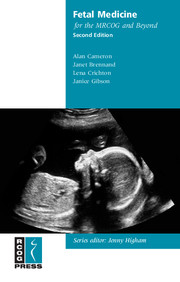Book contents
- Frontmatter
- Contents
- Preface
- Abbreviations
- 1 Screening for chromosomal abnormalities
- 2 Prenatal diagnostic techniques
- 3 The routine anomaly scan
- 4 Fetal structural abnormalities
- 5 Fetal therapy
- 6 Prenatal diagnosis and management of non-immune hydrops fetalis
- 7 Termination of pregnancy for fetal abnormality
- 8 Fetal growth restriction
- 9 Twin pregnancy
- 10 Fetal infection
- Index
10 - Fetal infection
Published online by Cambridge University Press: 05 August 2014
- Frontmatter
- Contents
- Preface
- Abbreviations
- 1 Screening for chromosomal abnormalities
- 2 Prenatal diagnostic techniques
- 3 The routine anomaly scan
- 4 Fetal structural abnormalities
- 5 Fetal therapy
- 6 Prenatal diagnosis and management of non-immune hydrops fetalis
- 7 Termination of pregnancy for fetal abnormality
- 8 Fetal growth restriction
- 9 Twin pregnancy
- 10 Fetal infection
- Index
Summary
Introduction
There are many infections that have the potential to pose risk to the fetus and neonate. When considering congenital infection, it is important to take account of a number of factors. Who is at risk of infection and what is the risk of transmission to the fetus? What is the best method of diagnosing fetal infection and, if the fetus is infected, can we predict whether or not it is affected and if so to what extent? Is there anything that can be done to prevent or treat fetal infection? This chapter addresses these questions for some of the infections that are associated with adverse outcome in pregnancy.
Cytomegalovirus
Cytomegalovirus (CMV) is the leading cause of congenital viral infection and is, as a result, a common cause of sensorineural deafness and mental restriction. It is found in all geographical locations. In industrialised countries, approximately 50% of women are immune to CMV at the outset of pregnancy.
CMV is a member of the herpes family. A feature of this family of viruses, which includes herpes simplex, varicella zoster and Ebstein Barr virus, is that after primary infection the virus remains alive but usually dormant within the host's body. There is therefore the potential for reactivation of infection at a time distant from the primary infection.
Primary infection occurs in 1–2 % of pregnancies and is responsible for approximately two-thirds of the cases of congenital CMV. Recurrent infection accounts for the remaining one-third of cases of congenital CMV. The vertical transmission rate is 20–40% following primary infection and approximately 1% following recurrent infection.
- Type
- Chapter
- Information
- Fetal Medicine for the MRCOG and Beyond , pp. 173 - 202Publisher: Cambridge University PressPrint publication year: 2011



